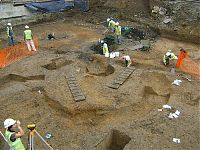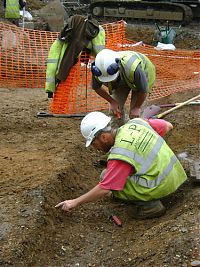A Circular Cut Feature
- By: Ashley Pooley |
- Sep 08, 2008
- Share
- del.icio.us

Today, before being rudely interrupted by infelicitous weather, Fergal and I have been excavating a circular cut feature. This has been present for a couple of weeks now, is subtly defined, and therefore slightly tricky to dig. We have been casually referring to it as a “ring ditch,” which is normally archaeologists’ shorthand for a shallow gully around the outside of an Iron Age roundhouse.
Its presence on a Roman site is, therefore, interesting. It is cut into the backfill of what are assumed to be large Roman quarry pits and is itself cut by further later quarry pits and a Roman inhumation. This tells us that it probably belongs solidly within the first broad phase of activity on site represented by gravel extraction and pre-dating the late-2nd to 3rd century usage of the site as a cemetery. It ought to be said that we don’t yet definitely know that it is a building (it might, for instance, be a small circular enclosure of uncertain function, although this is unlikely to be related to the cemetery phase for the reasons outlined above.) However, thus far, we have failed to produce any evidence both for its use as a domestic dwelling (which might be expected in the form of a hearth, for instance, and dumps of domestic waste hereabouts) nor any real structural remains (particularly postholes); it is also slightly on the small size for a roundhouse.
To jump bravely into the realms of speculation, however, we might suggest that this could be a shelter built and used by workers extracting gravel from this quarry. Interestingly, on this interpretation, they would have been using a building form placed firmly in the indigenous tradition (perhaps giving a clue to their origins and social status) within or alongside a settlement which appears to have been heavily Romanised (particularly in architectural forms) from the outside. Its position on the periphery of the settlement is mirrored by similar structures found on the outskirts of early Roman Chichester, for instance. By the time that the basilica was rebuilt within the centre of the Roman town, the labourers were using temporary buildings shaped like the more conventional Roman structures.
How times changed.

